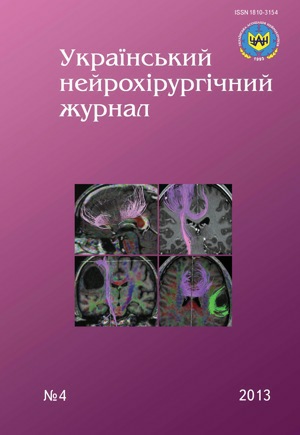Results of surgical treatment of patients with cerebral oligoastrocytoma
DOI:
https://doi.org/10.25305/unj.55413Keywords:
oligoastrocytoma, histological structure, surgical treatmentAbstract
Introduction. Long-term results of surgical treatment of 163 patients with cerebral oligoastrocytoma (OA) taking into consideration their histological structure were analyzed.
Materials and methods. OA of the II degree of anaplasia were diagnosed in 32 (19.6%) cases, of the III degree — in 123 (75.4%). In 8 (5%) cases OA structure was similar to glioblastoma.
Results. In OA tissue in 52 (32%) cases oligodendroglial component predominated, in 48 (29%) — astrocytic, in 63 (39%) — relatively even distribution of cells of both components. Life expectancy at OA of the II degree of anaplasia was in average (55±12.3) months, of the III degree — (24±6.5) months, of the III–IV degree — (6±2.3) months.
Conclusions. Long-term results of surgical treatment of patients with OA significantly correlate with features of these tumors histological structure.References
1. Central Brain Tumor Registry of the United States [Internet] / 2007–2008. Available at: http://www.cbtrus.org.
2. Tamura M, Zama A, Kurihara H, Kano T, Imai H, Ihiuchi S, Iwai T, Naito I. Clinicohistological study of oligodendroglioma and oligoastrocytoma. Brain Tumor Pathol. 1997;14(1):35-9. [CrossRef] [PubMed]
3. Hussein MR, Baidas S. Advances in diagnosis and management of oligodendroglioma. Expert Rev Anticancer Ther. 2002 Oct;2(5):520-8. [CrossRef] [PubMed]
4. Shaw EG, Scheithauer BW, O'Fallon Jr, Davis DH. Mixed oligoastrocytomas: a survival and prognostic factor analysis. Neurosurgery. 1994 Apr;34(4):577-82. [PubMed]
5. Ng WH, Lim TC, Tan KK. Disseminated spread of recurrent oligodendroglioma (WHO grade II). J Clin Neurosci. 2006 Jun;13(5):602-7. [PubMed]
6. Reifenberger G, Kros JM, Burger P. Oligodendroglioma. World Health Organization classification of tumours. In: Kleihues P, Cavenee WK, editors. Pathology and Genetics of Tumours of the Nervous System. Lyon: IARC Press; 2000. p.55-70.
7. Allam A, Radwi A, El Weshi A, Hassounah M. Oligodendroglioma: an analysis of prognostic factors and treatment results. Am J Clin Oncol. 2000 Apr;23(2):170-5. [CrossRef] [PubMed]
8. Shaw EG, Scheithauer BW, O'Fallon JR, Tazelaar HD, Davis DH. Oligodendrogliomas: the Mayo Clinic experience. J Neurosurg. 1992 Mar;76(3):428-34. [PubMed]
9. Shaw EG, Scheithauer BW, O'Fallon JR. Supratentorial gliomas: a comparative study by grade and histologic type. J Neurooncol. 1997 Feb;31(3):273-8. [PubMed]
10. Koeller KK, Rushing EJ. From the archives of the AFIP: Oligodendroglioma and its variants: radiologic-pathologic correlation. Radiographics. 2005 Nov-Dec;25(6):1669-88. [CrossRef] [PubMed]
11. Naugle DK, Duncan TD, Grice GP. Oligoastrocytoma. Radiographics. 2004 Mar-Apr;24(2):598-600. [CrossRef] [PubMed]
12. Klein M, Fagel S, Taphoorn MJB. Neurocognitive functioning in long-term low-grade glioma survivors: a six year follow-up study. Neuro-Oncol. 2006;8:302.
13. Olson JD, Riedel E, DeAngelis LM. Long-term outcome of low-grade oligodendroglioma and mixed glioma. Neurology. 2000 Apr 11;54(7):1442-8. [CrossRef] [PubMed]
14. Pignatti F, van den Bent M, Curran D, Debruyne C, Sylvester R, Therasse P, Afra D, Cornu P, Bolla M, Vecht C, Karim AB; European Organization for Research and Treatment of Cancer Brain Tumor Cooperative Group; European Organization for Research and Treatment of Cancer Radiotherapy Cooperative Group. Prognostic factors for survival in adult patients with cerebral low-grade glioma. J Clin Oncol. 2002 Apr 15;20(8):2076-84. [PubMed]
15. Dehais C, Laigle-Donadey F, Marie Y, Kujas M, Lejeune J, Benouaich-Amiel A, Pedretti M, Polivka M, Xuan KH, Thillet J, Delattre JY, Sanson M. Prognostic stratification of patients with anaplastic gliomas according to genetic profile. Cancer. 2006 Oct 15;107(8):1891-7. [CrossRef] [PubMed]
16. Miller CR, Dunham CP, Scheithauer BW, Perry A. Significance of necrosis in grading of oligodendroglial neoplasms: a clinicopathologic and genetic study of newly diagnosed high-grade gliomas. J Clin Oncol. 2006 Dec 1;24(34):5419-26. [CrossRef] [PubMed]
17. Lindegaard KF, Mork SJ, Eide GE, Halvorsen TB, Hatlevoll R, Solgaard T, Dahl O, Ganz J.Statistical analysis of clinicopathological features, radiotherapy, and survival in 170 cases of oligodendroglioma. J Neurosurg. 1987 Aug;67(2):224-30. [PubMed]
18. Leighton C, Fisher B, Bauman G, Depiero S, Stitt L, MacDonald D, Cairncross G. upratentorial low-grade glioma in adults: an analysis of prognostic factors and timing of radiation. J Clin Oncol. 1997 Apr;15(4):1294-301. [PubMed]
19. McCarthy BJ, Propp JM, Davis FG, Burger PC. Time trends in oligodendroglial and astrocytic tumor incidence. Neuroepidemiology. 2008;30(1):34-44. [CrossRef] [PubMed]
Downloads
Published
How to Cite
Issue
Section
License
Copyright (c) 2013 Volodymyr Rozumenko, Vera Semenova, Valentyn Klyuchka

This work is licensed under a Creative Commons Attribution 4.0 International License.
Ukrainian Neurosurgical Journal abides by the CREATIVE COMMONS copyright rights and permissions for open access journals.
Authors, who are published in this Journal, agree to the following conditions:
1. The authors reserve the right to authorship of the work and pass the first publication right of this work to the Journal under the terms of Creative Commons Attribution License, which allows others to freely distribute the published research with the obligatory reference to the authors of the original work and the first publication of the work in this Journal.
2. The authors have the right to conclude separate supplement agreements that relate to non-exclusive work distribution in the form of which it has been published by the Journal (for example, to upload the work to the online storage of the Journal or publish it as part of a monograph), provided that the reference to the first publication of the work in this Journal is included.









